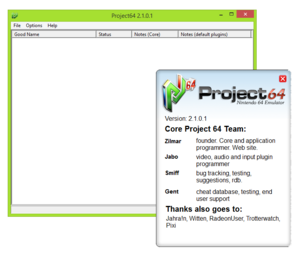Project64
Topic: Software
 From HandWiki - Reading time: 4 min
From HandWiki - Reading time: 4 min
 | |
 Project64 2.1.0.1 running on Windows 8.1 | |
| Developer(s) | Zilmar Shygoo Azimer[1] |
|---|---|
| Initial release | May 26, 2001 |
| Stable release | 3.0.1
/ July 30, 2021[2] |
| Repository | github |
| Written in | C, C++ |
| Operating system | Windows, Android |
| Available in | Multi-language |
| Type | Video game console emulator |
| License | GPL-2.0-only |
| Website | www |
Project64 is a free and open-source Nintendo 64 emulator written in the programming languages C and C++ for Microsoft Windows.[3] This software uses a plug-in system allowing third-party groups to use their own plug-ins to implement specific components. Project64 can play Nintendo 64 games on a computer reading ROM images, either dumped from the read-only memory of a Nintendo 64 ROM cartridge or created directly on the computer as homebrew.[4]
Project64 is considered one of the top performing emulators used today and the most popular Nintendo 64 emulator.[5][6] The program is licensed under the GNU General Public License version 2.
Compatibility and features
Project64 is considered a highly compatible emulator which does not require the use of a Basic Input/Output System (BIOS). The emulator has basic features, supports multiplayer, and allows alternating the aspect ratio without cropping or quality drop.[7]
Development history
Development of Project64 began in March 1998 with a small team consisting of Zilmar and others. In September 1999, Zilmar was introduced to Jabo, who was developing an N64 Emulator of his own. In December 1999, Jabo was invited to join Zilmar on a collaborative effort for Project64. Jabo initially did not intend on being the RDP/Graphics developer, having a greater interest in assembly language and the central processing unit (CPU) but found himself often working on the graphics aspects.[8]
The authors have released certain parts of the source code for the now unsupported version 1.4. Project64k is a modified version of Project64 1.4 which provides multiplayer netplay abilities via integrating the Kaillera networking client. Players are able to join servers where multiple games may be hosted with other features remaining consistent with Project64 1.4.[9] In July 2011, Jabo decided to stop developing Project64 and released a modified version of 1.6 with some improvements.[10] He also stated that no more releases of the source code were going to happen.[11] However, in April 2013, Zilmar released both Project64 2.0 and an official repository of its source code that was made available on the Project64 website making the software fully open-source and accessible to everyone. It was mentioned that a major part of the code was rewritten in this version.[12] Then about a month later, Project64 2.1 was released.[13] In April 2015, Project64 2.2 was released along with its source code in a GitHub repository.[14] From May 2015 onwards Project64 2.2 was able to play 64DD disk roms.[15] On August 1, 2016, Project64 version 2.3 was released, eventually being updated to version 2.3.2 in January 2017.[16] On May 27, 2021, Project64 version 3.0.0 was released to celebrate its 20th anniversary.[17]
Reception
In 2011, PC World praised the emulator for offering more "advanced settings" than Nintendo's official Nintendo 64 emulation available through the Virtual Console, such as the ability to change the game's aspect ratio, but criticized the emulation for being imperfect, describing it as "rough around the edges".[18]
However, up to version 2.2, there were major safety concerns of installing Project64 through its official installer after numerous reports on social media websites of the installers containing malware.[19] Fortunately, in July 2016, this malware code was removed from both the source code and its installers. When Project64 2.3 was released, a harmless yet irritating nagware screen began to occur after a number of uses of the software which grew more persistent with successive launches as a forced waiting period is installed. The emulation community, however, has managed to find a way around this issue.[20]
See also
- List of video game emulators
- Mupen64Plus, an alternative Nintendo 64 emulator
References
- ↑ "Discord - A New Way to Chat with Friends & Communities". https://discord.com/invite/Ztt6CfF.
- ↑ "Project64 Download - Windows". https://www.pj64-emu.com/public-releases.
- ↑ Castro, Radford (2004). Let Me Play: Stories of Gaming and Emulation. Hats Office Books. ISBN 1587363496. https://books.google.com/books?id=D_xyy4fkwWIC&q=Project64+emulator. Retrieved February 21, 2014.
- ↑ Gurunathan, Sriram (February 4, 2011). "Top Five Emulators". Tech 2. http://tech.firstpost.com/news-analysis/top-five-emulators-17694.html.
- ↑ Hayward, David (July 19, 2013). "Retro console emulators group test: Project 64 2.1 review". http://www.micromart.co.uk/gaming/group-test-retro-console-emulators/1025/retro-console-emulators-group-test-project-64-21.
- ↑ Snyder, Craig (May 12, 2013). "Project64 – The Best Way To Emulate Nintendo 64 Games". https://www.makeuseof.com/tag/project64-is-the-best-way-to-emulate-nintendo-64-games/.
- ↑ Brandon Widder (April 20, 2013). "Best Emulators (NES, SNES, Genesis, N64, and more)". https://www.digitaltrends.com/gaming/best-emulators/.
- ↑ Redah. "Interview with Zilmar and Jabo of Project64". http://www.emulation64.com/pj64interview.php.
- ↑ "Project 64 Kaillera". https://pj64k.blogspot.com/.
- ↑ "Project64 1.6.1". Jabosoft.com. http://www.jabosoft.com/articles/114#74.
- ↑ "Project64 1.6.1". Jabosoft.com. http://www.jabosoft.com/articles/114.
- ↑ Zilmar (April 1, 2013). "Project64 2.0 is now available and open source!". http://forum.pj64-emu.com/showthread.php?t=3573.
- ↑ Zilmar (May 1, 2013). "Project64 2.1". Project64 Forums. http://forum.pj64-emu.com/showthread.php?t=3678.
- ↑ Zilmar (April 1, 2015). "Project64 2.1". Project64 Forums. http://forum.pj64-emu.com/showthread.php?t=4969.
- ↑ "64DD.org". May 1, 2015. https://64dd.org/.
- ↑ "Project64 Download - Windows". https://www.pj64-emu.com/public-releases.
- ↑ "Project64 Celebrates Its 20th Anniversary With A 3.0 Update". https://www.nintendolife.com/news/2021/05/project64_celebrates_its_20th_anniversary_with_a_3_0_update.
- ↑ Garnett, Alex (September 1, 2011). "How to Emulate the Nintendo 64 (N64) on Your PC". https://www.pcworld.com/article/239155/how_to_emulate_the_nintendo_64_n64_on_your_pc.html.
- ↑ "r/Games - A warning to those looking to download an N64 emulator. Project64's installer is bundled with malware. Not completely sure if it actually installs, so I advise some small caution." (in en). https://www.reddit.com/r/Games/comments/1qloev/a_warning_to_those_looking_to_download_an_n64/.
- ↑ "Project64 - Emulation General Wiki". http://emulation.gametechwiki.com/index.php/Project64.
External links
 |
 KSF
KSF